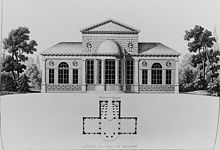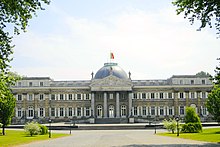Charles de Wailly

Charles de Wailly
Biography
De Wailly was born in Paris. Starting in 1749, he was the pupil of Jacques-François Blondel at l'École des Arts, where he met William Chambers and had as a schoolmate Marie-Joseph Peyre; later he studied with Giovanni Niccolò Servandoni and with Jean-Laurent Le Geay. After having obtained the Prix de Rome for architecture in 1752 he went to the French Academy in Rome for three years until 1755, sharing his prize with his friend Pierre-Louis Moreau-Desproux. Both participated in the excavations at the Baths of Diocletian. In Rome, de Wailly founded a friendship with the sculptor Augustin Pajou, who was to carve his bust and that of his wife and for whom, in 1776, he would build a house adjoining his own, in Paris.
On his return to Paris, de Wailly showed his mastery of the earliest version of neoclassicism, being called the "
About 1764, for the sumptuous Hôtel d'Argenson de Voyer, which he remodelled for Marc-René d'Argenson, marquis de Voyez in an advanced neoclassical style, he designed the gilt-bronze mounted marble and porphyry vase on pedestal that is now in the Wallace Collection, London;[3] from de Wailly's drawings the sculptor Augustin Pajou made the wax models for the mounts.
In 1767, de Wailly was accepted as a member of the first class of the
His reputation abroad grew through engravings of his works; he became particularly popular in Russia, where his disciples, some of whom went to Paris to study with him directly, included Vasily Bazhenov, Ivan Starov, and Andrey Voronikhin. Catherine the Great offered him a high post in the Imperial Academy of Arts, St Petersburg, which he refused.
In 1772, he was named site architect of the
Noticed by the
In 1795, he was elected to the Académie des Beaux-Arts – 3rd section (architecture), fauteuil V. With his death, Jean Chalgrin succeeded to his seat. He became conservator of the museum of painting in 1795 and was sent to the Netherlands and Belgium to select works of art after the annexation of these countries.
He married Adélaïde Flore Belleville who, after his death, remarried in 1800 to the chemist
De Wailly died in Paris in 1798.
Works
France





- Hôtel d'Argenson (also called the Hôtel de la Palais Royal in Paris (destroyed in 1923): interior installations carried out for the Comte d' Argenson[6](1762–1770).
- Transformation of the ) for the comte d'Argenson.
- Château de Montmusard near Dijon (Côte d'Or) (1765–1768): main architectural work of the Goût Grec in France, unfortunately mainly destroyed as of 1795.
- Maison 57 rue La Boétie in Paris, constructed by de Wailly for himself (1776).
- Maison 87 rue de la Pépinière, today rue La Boétie, for the sculptor Augustin Pajou.
- Decoration of the chapel of the Virgin in Saint-Sulpice(1774–1777).
- Temple des Arts at the marquis de Marigny. De Wailly also provided and project for a Temple du Repos for the park at Ménars, which was not executed.
- Monsieur, brother of the King, the plans of Peyre and de Wailly finally won the day in the autumn of 1778. Works began in May 1779. Peyre would be principally responsible for the exterior and de Wailly for the interiors. On 16 February 1782, the troupe of the Comédie-Française were established in their own precincts. The theatre was inaugurated by Marie Antoinette, 9 April 1782.[7]
- De Wailly gave an overall plan for the construction of the district around the new theatre, allotting a Cartesian plan. The buildings however were not carried out until a long time after the completion of the theatre, towards 1794.
- At the Église Saint-Leu-Saint-Gilles, Rue Saint-Denis in Paris: de Wailly created a choir for the Order of the Holy Sepulchre, and an underground cryptdecorated in an original Doric order.
- Project for embellishment of the town of Paris (1789): this first plan for remanagement acts to foreground the overall refitting of the capital, with creating new passageways, reuniting the îles de la Cité and Saint-Louis, correction of the course of the Seine, etc.[1]
- Plan of new Port-Vendres.
- Chapelle du Reposoir, Palace of Versailles.
Belgium

- Design for a new château for the Arenberg family in the Enghien Gardens (1784 - not realized)
- Small theatre of the château de Seneffe à Seneffe (1779).
- Vaux-Hall (today: Cercle Royal Gaulois), Brussels (1782).
- Théâtre Royal du Parc, Brussels(1783).
- Renovation of La Monnaie, Brussels (1785).
- Château royal de Laeken.
- Castle Ter Rivierenhof, Deurne, Antwerp (1779).
Germany
- Reorganisation of Kassel city center.
Russia
- Palais Sheremetev in Kuskovo.
Notes
- ^ The "de" in the name "de Wailly" is not a nobiliary particle but finds its origin in the Flemish definite article "der".[citation needed] It is usual practice to refer to him as "de Wailly" ("De Wailly" at the beginning of a sentence) and not "Wailly". However, the name is generally indexed as "Wailly, Charles de". (An exception is found in Eriksen 1974, however, his example has not been followed by subsequent authors, such as Braham 1980 or Cleary 1998.) During the Revolution de Wailly began to sign his name "Dewailly" (Braham 1972, p. 673 note 7), but this form of the name has not been generally adopted.
- ^ Eriksen 1974, p. 274.
- ^ Illustrated in Duffy 2005, p. 188.
- ^ Braham 1972, p. 673, noting the case of Charles-Louis Clérisseau's debatable position as a working architect.
- ^ An elevation of the salone, dated 1773, is in the Musée des Arts Décoratifs, Paris.
- Marc-René de Voyer de Paulmy d'Argenson (1722-1787).
- ^ Théâtre de l'Odéon at Structurae
References
- Braham, Allan (1972). "Charles de Wailly and Early Neo-Classicism", The Burlington Magazine 114 No. 835 (October 1972), pp. 670–685.
- Braham, Allan (1980). The Architecture of the French Enlightenment. Berkeley: University of California Press. ISBN 9780520067394.
- Cleary, Richard (1998). "Wailly, Charles de" in Turner 1998, vol. 32, pp. 766–769.
- Duffy, Stephen (2005). The Wallace Collection. London: Scala. ISBN 9781857594225(paperback).
- Eriksen, Svend (1974). Early Neo-Classicism in France, translated by Peter Thornton. London: Faber & Faber.
- Rabreau, D.; Mosser, M. (1979). Charles De Wailly (1730-1798), peintre-architecte dans l'Europe des Lumières. Paris: Caisse nationale des monuments historiques et des sites.
- Réau, Louis (1924). Histoire de l'expansion de l'art français: le monde slave. Listings at WorldCat.
- Turner, Jane, editor (1998). ISBN 9781884446009.
External links
- (in French) Notice sur le château de Montmusard
- Portrait bust of de Wailly (1789) by Augustin Pajou at the Palais des Beaux-Arts de Lille
